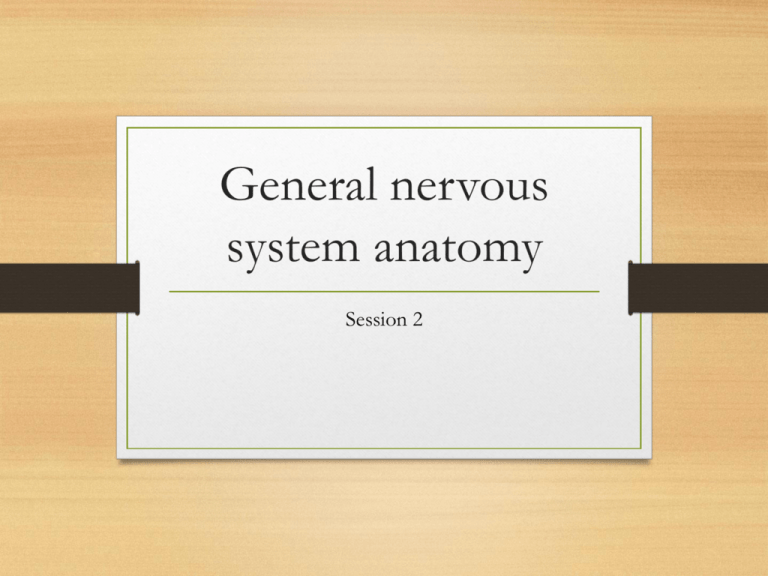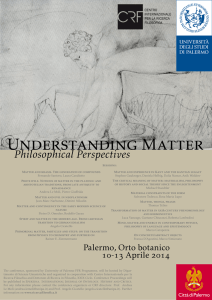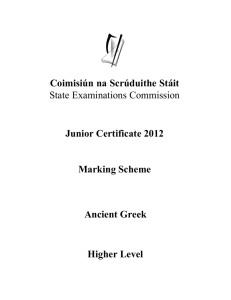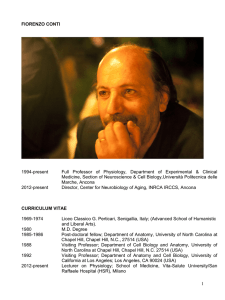30 Answer Now - 34-602-Neuroanatomy-SP15
advertisement

General nervous system anatomy Session 2 What do you think? Objectives • Recognize the surface of the brain from every perspective • Correctly use the terms for the anatomical breakdown of the central nervous system • Compare and contrast white and gray matter and recognize terms that distinguish them • • • • • • Describe the structure of the spinal cord Recognize cross-sections of the brain in each plane Describe the locations and functions of supporting systems of the CNS Describe the difference between a tract and a pathway Visualize a second order sensory neuron Discuss the role of major neurotransmitters Who originally proposed the Cell Theory in 1839? Paul Broca Theodor Schwann Charles Darwin Th Answer Now es Re ne De s ca rt in r le sD ar w Ch a eo do rS ch Br o wa n n ca Rene Descartes Pa ul A. B. C. D. 25% 25% 25% 25% :30 Alzheimer’s and Parkinson’s are both characterized by progressive degeneration of specific neurons in the peripheral nervous system. 50% 50% se Fa l Tr Answer Now ue A. True B. False :30 Developmental vs anatomical breakdown Rostral • Development based terms (left) Cerebrum • Visible structure based terms (right and middle) Midbrain • Cellular level based terms (for later on) • Nuclei, internal structures, Pons Medulla etc. Caudal White matter vs gray matter • White: • Tract, capsule, commissure, lemniscus, fasciculus, column, peduncle, funiculus, crus • Gray: • Ganglia, nuclei, cortex, specialized names (like thalamus) Spinal region • Gray matter • Horns (anatomical) • Laminae (functional) • White matter • Funiculi (anatomical) • Tracts, columns, lemnisci, etc. (functional) • Surface Features • Fissures, Meninges, Arteries lemnisci contain synapses Tr Answer Now se ue A. True B. False 50% Fa l 50% :30 brainstem cerebellum • Crus = Peduncle • Lined with gray matter just like cerebral cortex • Word cerebellum is a diminutive of cerebrum (minibrain) Cerebellum – arbor vitae Subcortical structures • Diencephalon • Basal Ganglia • Lenticular Nuclei • Corpus Striatum • Parts of Limbic System Cerebral cortex • https://www.youtube.com/watch?v=6M0XbFa6Qn Y • Watch a zebrafish think! (kind of) Where is the tectum located? Midbrain 25% 25% 25% Pons Medulla n alo nc ep h ed Po ns ul la Di e Answer Now M id br a in Diencephalon M A. B. C. D. 25% :30 Cerebral cortex • Gray matter cortex – gyri and sulci to increase area • Increased cortex area = increased processing space* • White matter – connects cortex with other processing structures • Increased white matter = increased processing power or speed* *Professor Burnell’s unresearched hypotheses Cerebral cortex microscope slide (stained) Cerebrum vs cerebellum • Brain vs. mini-brain • Gray cortex, white tracts, deep nuclei • Arbor vitae = capsules and commissures • Peduncles • Cerebellum function: • Coordination, balance, subconscious motor control, unknown • Cerebrum function: • Sensation, conscious motor control, language, planning, etc., mostly known identify the surfaces Which views allow you to see the 4th ventricle? 20% 20% 20% 20% 20% A. Anterior view of brainstem B. Posterior view of brainstem with cerebellum removed C. Posterior view of brainstem Answer Now in st em of br a se ct vi ew sa git ta l id La te r al M w of b ra i ns .. . ns t.. of b io rv ie w Po st er io rv ie Po st er An te r io rv ie w of br a ra i in ste m D. Midsagittal section E. Lateral view of brainstem io n with cerebellum intact :30 Cross sections • Sagittal (midsagittal) • Coronal/Frontal • Horizontal/Transverse/Axial Cross Sections - midsagittal • Cerebral cortex, diencephalon, brainstem Cross sections - coronal • Cerebral cortex and subcortical structures Cross sections - axial • Cerebral cortex, subcortical structures, brainstem, cerebellum, spinal cord The lateral ventricles appear in two places (4 total) in which cross section? Answer Now sa git ta l l 33% id M Co r on a l A. Coronal B. Axial C. Midsagittal 33% Ax ia 33% :30 What term best describes these structures? sy st em 33% L im bi c ga n sa l Ba Le nt ifo rm nu c le i A. Lentiform nuclei B. Basal ganglia C. Limbic system 33% gli a 33% Answer Now :30 What is the name of this structure? Tectum Basis Pontis Mammillary body Crus Cerebri ri Cr u sC er eb od y ar yb ill am m M Ba sis ct um Po nt is 25% 25% 25% 25% Te A. B. C. D. Answer Now :30 Support Systems • Arteries • Vertebral -> Basilar -> Circle of Willis • Internal Carotid -> Circle of Willis • Veins, Sinuses • Superior Sagittal Sinus • CSF – Ventricles, aqueducts, canals • Lateral ventricles -> (interventricular foramen) -> 3rd ventricle -> (cerebral aqueduct) -> 4th ventricle -> SAS • Meninges • Pia, SAS, Arachnoid, SDS, Dura After flowing through the lateral ventricles, where does the CSF travel next? 20% 20% 20% 20% 20% 4th ventricle 3rd ventricle SAS Cerebral aqueduct Answer Now en nt r icu la rf or am qu ed uc t ve In te r Ce re b ra la SA S nt ri ve 3r d ve nt ri c le c le Interventricular foramen 4t h A. B. C. D. E. :30 Tracts vs pathways • Pathway is the whole road trip, including stops • Tract is one road • Decussations Sensory vs motor pathways • Sensory pathways tend to have 3 neurons (primary, secondary, tertiary) • Motor pathways tend to have 2 neurons (upper and lower) First, Second, Third Order Sensory Neurons • 1st (primary) • 2nd (secondary) • Tract • 3rd (tertiary) • Soma in thalamus • Ends in cortex Upper vs Lower Motor Neurons • Upper Motor Neurons • Soma in Cortex • Synapses in spinal cord, after decussating • Interneurons – processing • Lower Motor Neurons • Starts in spinal cord, exits through anterior root Lower Motor neurons cross midline. 50% se ue Tr Answer Now 50% Fa l A. True B. False :30 Neurotransmitters • Glutamate (+) • GABA (-) • Dopamine – reward system, mostly noticed when absent (parkinson’s, schizophrenia, ADHD, restless leg syndrome) • • • • • • • Serotonin – enteric NS, mood, sleep, learning, memory, etc. CCK (cholecystokinin) – enteric NS Acetylcholine – PNS Epinephrine Norepinephrine Substance P – pain perception Enkephalin – pain regulation Objectives • Recognize the surface of the brain from every perspective • Correctly use the terms for the anatomical breakdown of the central nervous system • Compare and contrast white and gray matter and recognize terms that distinguish them • • • • • • Describe the structure of the spinal cord Recognize cross-sections of the brain in each plane Describe the locations and functions of supporting systems of the CNS Describe the difference between a tract and a pathway Visualize a second order sensory neuron Discuss the role of major neurotransmitters conclusion • Questions on general anatomy? • Study Guide will be posted this afternoon • Read for next class: • Bear Ch. 7 • L-E Ch. 5 • Pdf attachment of Haines Ch. 8


